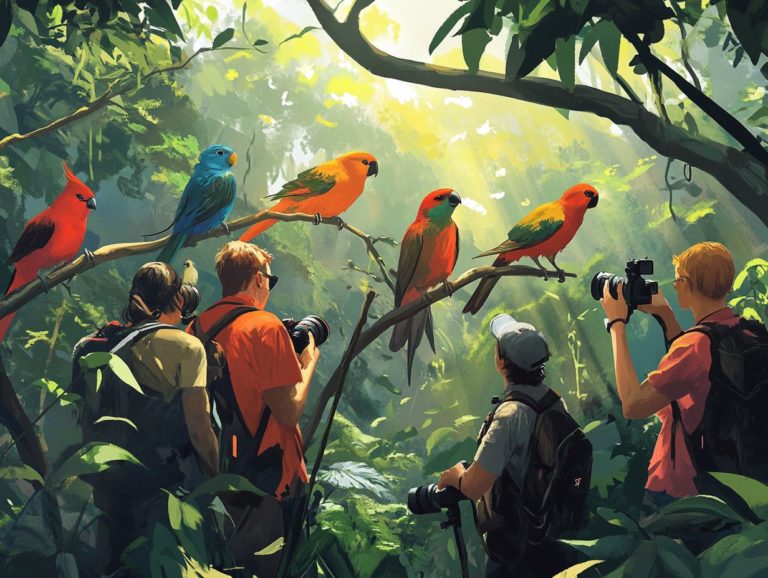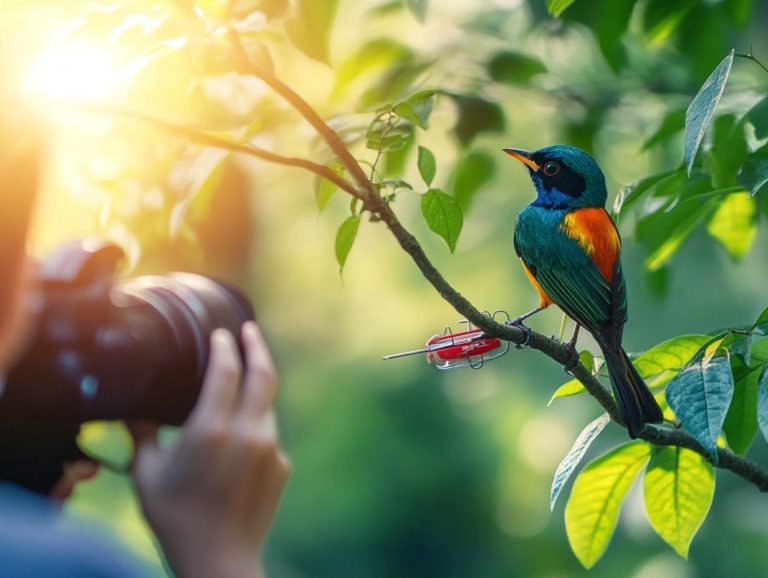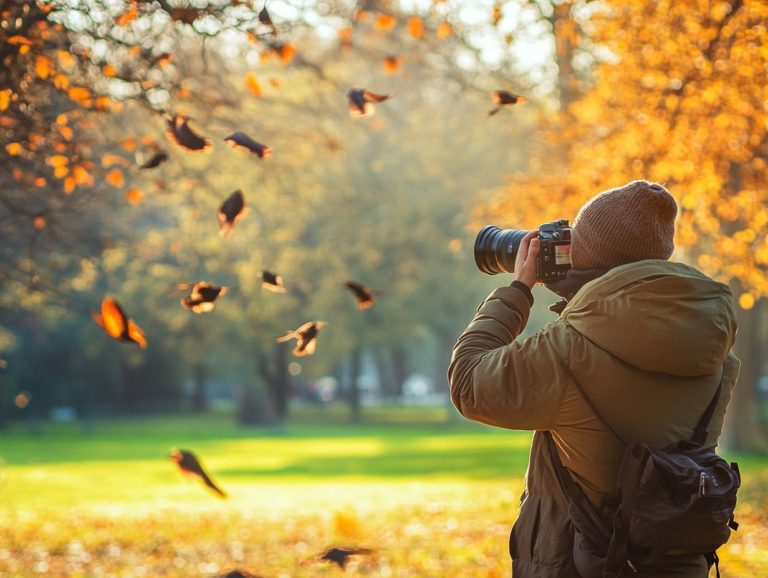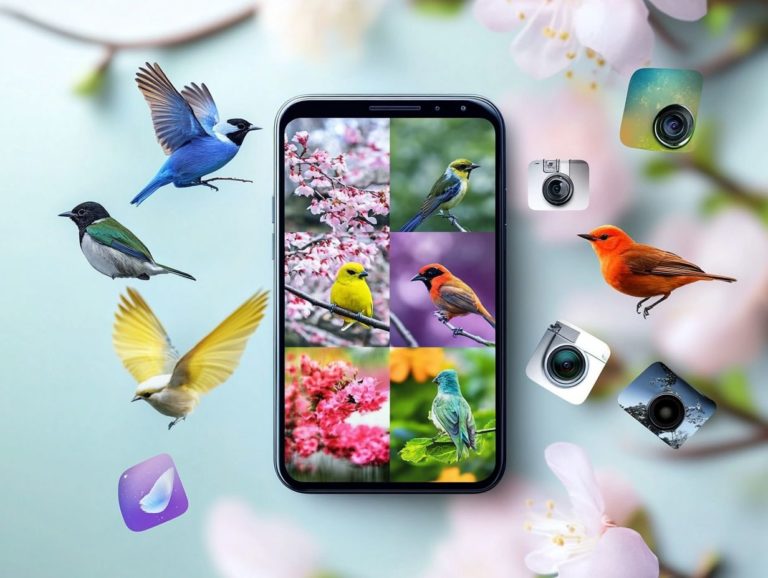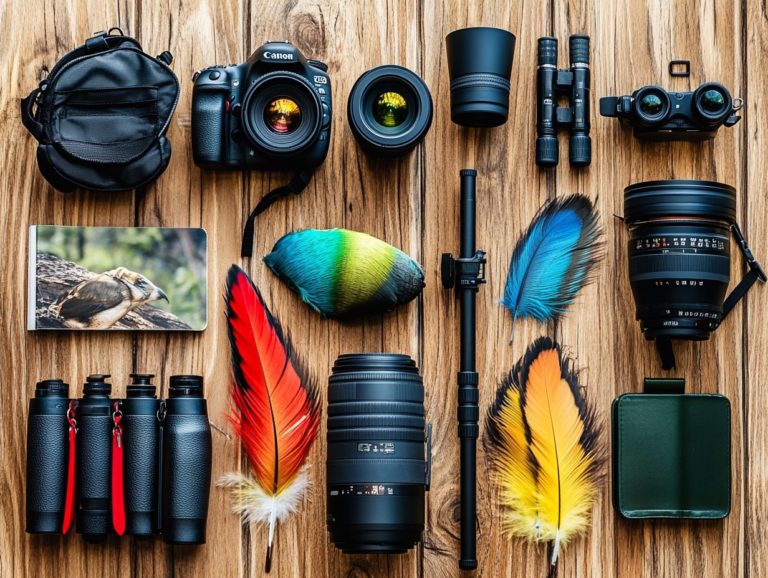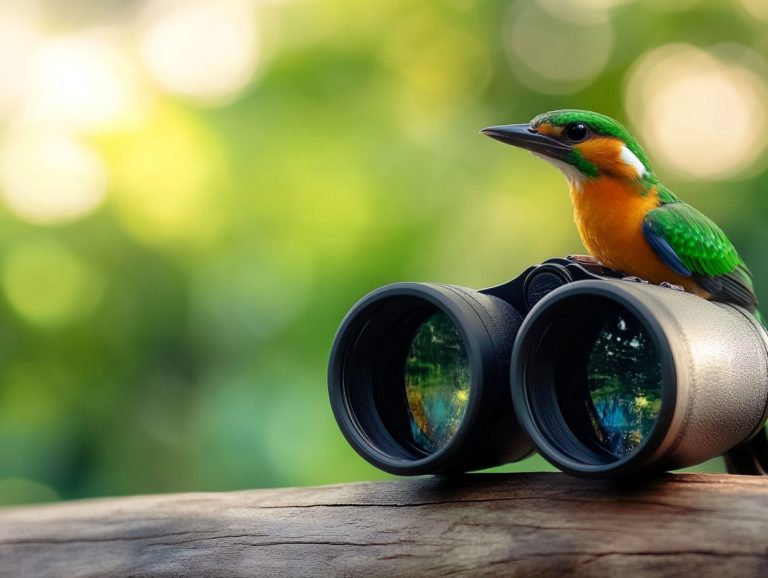Bird Photography: Understanding Depth of Field
Bird photography demands not just a keen eye but also a solid grasp of various techniques. Depth of field stands out as one of the most essential.
Get ready to uncover the exciting world of depth of field! This guide will explore its true significance in capturing breathtaking bird images. You will also discover the key factors that influence it, such as aperture, focal length, and distance.
You will find practical tips for effectively utilizing depth of field in your shots, common pitfalls to avoid, and expert advice designed to elevate your photography skills. Whether you re a seasoned photographer or just embarking on this journey, this information is crafted to enrich your bird photography experience.
Contents
- Key Takeaways:
- Overview of the Art and Practice
- Understanding Depth of Field
- Factors that Affect Depth of Field
- Using Depth of Field in Bird Photography
- Common Mistakes to Avoid
- Summary and Final Thoughts
- Frequently Asked Questions
- What is depth of field in bird photography?
- How does aperture affect depth of field in bird photography?
- What is the ideal depth of field for bird photography?
- How can I achieve a shallow depth of field in my bird photography?
- What is the effect of distance on depth of field in bird photography?
- Are there any other factors that can affect depth of field in bird photography?
Key Takeaways:
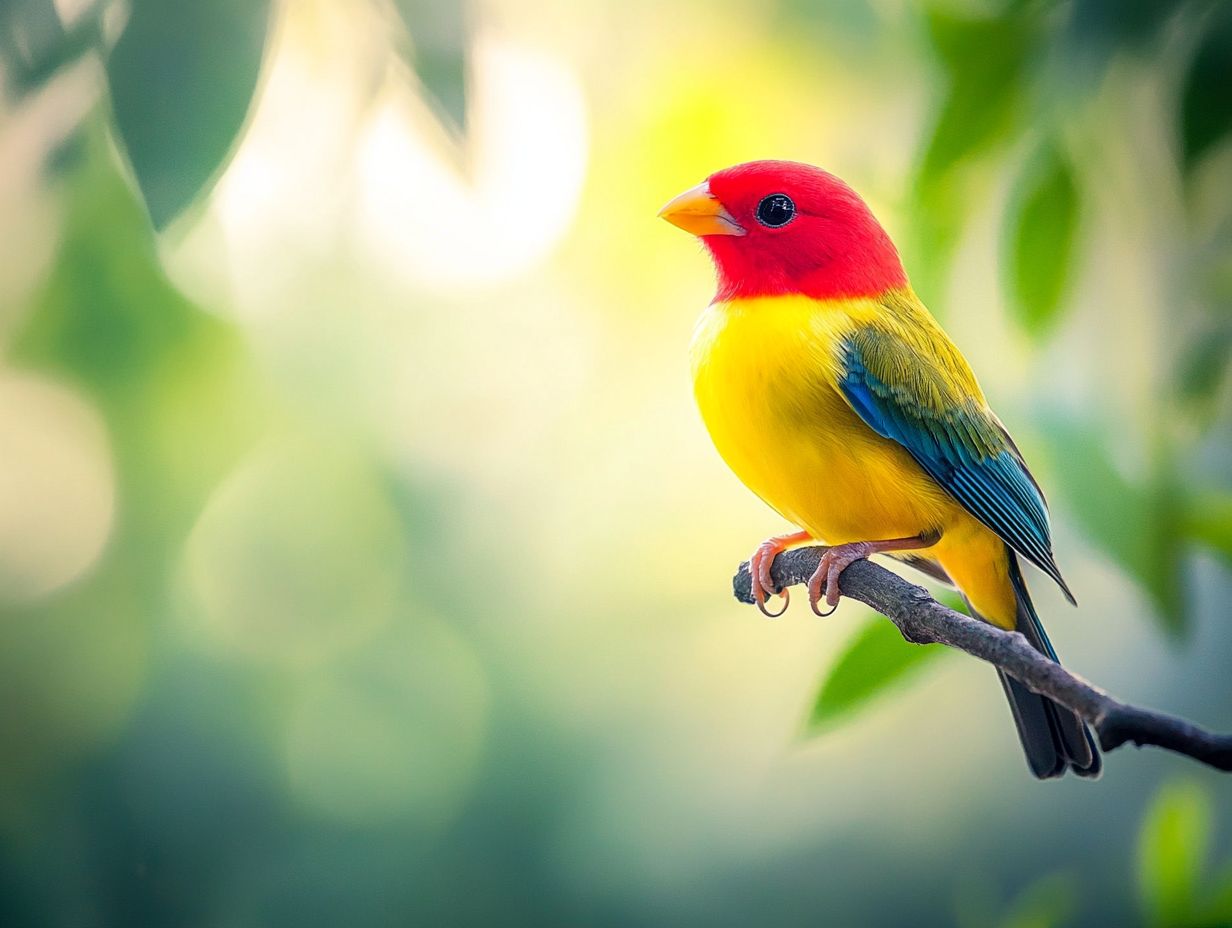
- Understanding depth of field is crucial in bird photography to create visually appealing images by controlling the sharpness and blurriness in the background.
- Factors such as aperture, focal length, and distance impact depth of field. Learning how to manipulate them can significantly improve your photos.
- Techniques like using a shallow depth of field and adjusting focus help you capture stunning bird images with a beautiful blur. Avoiding common mistakes like shooting at high apertures can enhance your photography skills.
Overview of the Art and Practice
Wildlife photography is a captivating art form that merges technical skill with a profound appreciation for nature. This is especially true when you aim to capture breathtaking images of exotic birds like the Crimson-rumped Toucanet and Giant Antpitta in Ecuador.
Mastering this art involves using long telephoto lenses and high-performance professional lenses. Pay attention to aperture values like f/4 and f/6.3, as these will help you achieve the desired depth of field and subject separation.
Sharpness becomes a top priority when photographing birds in their dynamic habitats. Your choice of equipment is essential. Consider models like the Nikon Z 180-600mm and Tamron 150-500mm; they are crucial for ensuring optimal capture in the field.
Understanding Depth of Field
Depth of field is a crucial element in wildlife photography. It profoundly impacts the visual narrative of the birds you capture.
By skillfully adjusting the largest opening in your camera s lens, you can craft stunning images that feature varying levels of depth. This technique allows for effective subject separation and elevates the overall sharpness of your scenes, turning simple shots into compelling stories.
Definition and Importance
Depth of field refers to the range of distance in your photos that appears sharp and in focus. It is a critical component of your photography settings, especially for capturing stunning wildlife images.
Achieving the right balance of sharpness is essential, particularly when you decide on the maximum aperture for those dynamic wildlife scenes. This concept significantly enhances both the clarity of your subject and the storytelling aspect of your images.
For example, using a wide aperture like f/2.8 creates a captivating bokeh effect, isolating a majestic eagle soaring against a softly blurred background. Alternatively, a narrower aperture like f/8 is perfect for capturing a lush landscape filled with animals, ensuring both the foreground and background remain in sharp focus.
By mastering these aperture settings and understanding depth of field, you can elevate your visual storytelling, capturing not just the subject but the essence of wildlife in its natural habitat.
Factors that Affect Depth of Field
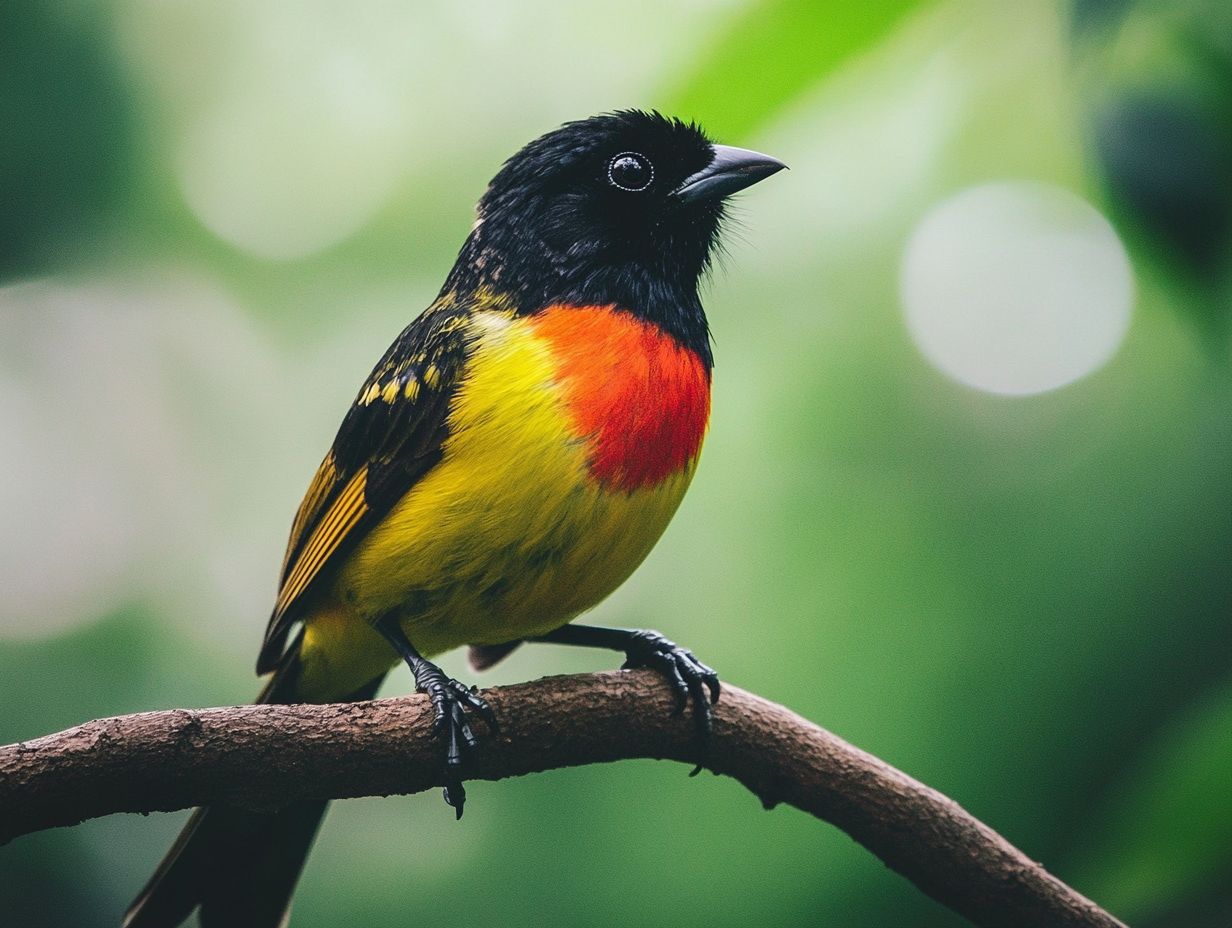
In wildlife photography, several key factors influence depth of field. These include aperture settings, focal length, and the distance to your subject.
Each of these elements plays a vital role in defining the sharpness of the birds you capture. By grasping these concepts, you can craft striking images that truly showcase your subjects against a stunning natural backdrop.
Start experimenting with your depth of field today and watch your bird photography soar!
Aperture, Focal Length, and Distance
Aperture, focal length, and distance are three pivotal elements that influence depth of field in wildlife photography. Each contributes uniquely to the overall sharpness of your images. Fine-tuning these parameters helps achieve the visual effects you desire and enhances subject separation.
For example, using a wide aperture like f/2.8 creates a shallow depth of field, allowing a subject such as a deer to stand out against a beautifully blurred background of foliage. Alternatively, opting for a smaller aperture like f/11 increases depth of field, keeping both the animal and its surroundings in sharp focus. This is particularly important when capturing a group of animals in their natural habitat.
The focal length plays a significant role in your photography. A longer lens compresses perspective, resulting in a pronounced bokeh effect that elegantly isolates your subject. Adjusting your shooting distance can also dramatically alter depth of field. Getting closer to your subject while maintaining optimal aperture settings often leads to striking wildlife portraits that captivate viewers.
Using Depth of Field in Bird Photography
Utilizing depth of field in bird photography can significantly enhance the aesthetic appeal of your images. This can transform ordinary shots into captivating works of art.
Employ various techniques and tips to improve subject separation and clarity. This ensures the beauty of each bird you capture stands out against its surroundings.
Techniques and Tips for Capturing Beautiful Images
To create breathtaking images in bird photography, you should use specific techniques that leverage depth of field, focusing on sharpness and effective subject separation. Mastering these tips can elevate your photographic skills and bring your wildlife images to life.
Utilizing a wide aperture setting can dramatically blur the background. This allows the vibrant plumage and intricate details of the bird to take center stage, creating a compelling composition. For instance, when photographing a hummingbird, selecting a lower f-stop value like f/2.8 can effectively isolate the bird from its surroundings, making it almost leap out of the frame.
Pay attention to the distance between the bird and the backdrop. Positioning your subject farther from cluttered elements in the background greatly enhances overall image quality. Experiment with techniques like the rule of thirds to enrich visual interest. This guides the viewer’s eye toward the captivating subject.
Common Mistakes to Avoid
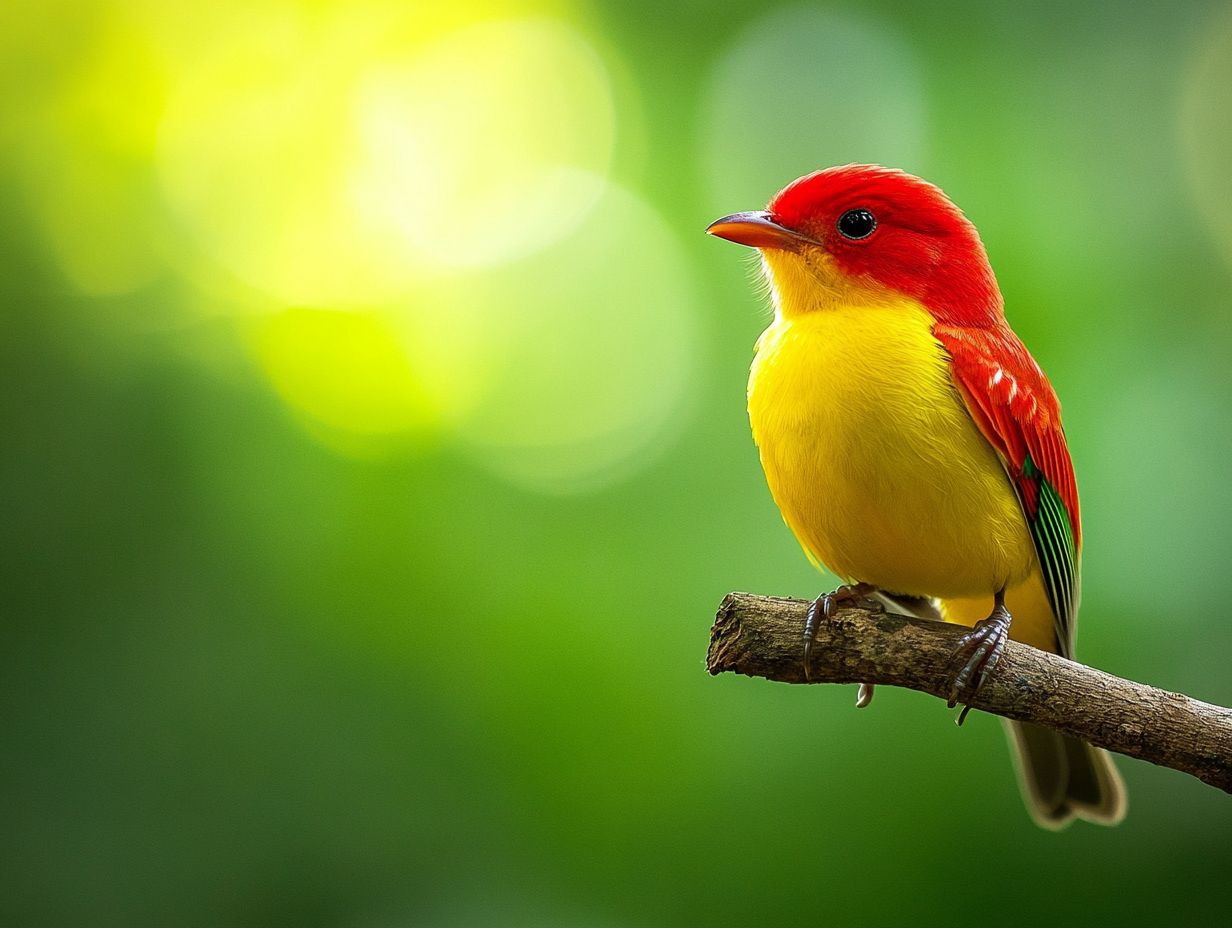
Wildlife photography has common mistakes that can lower image quality, especially regarding depth of field and sharpness. Recognizing these pitfalls enables you to fine-tune your photography settings, enhancing your ability to capture stunning images of birds in their natural habitat.
How to Overcome Common Challenges
Overcoming challenges in wildlife photography requires understanding sharpness concerns and effectively adjusting your photography settings, particularly depth of field. By employing strategic approaches, you can significantly enhance your ability to capture breathtaking images of birds, ensuring clarity and subject separation.
One effective method to improve sharpness is to use higher shutter speeds, which counteract the natural movements of wildlife. Incorporating a tripod or stabilizing gear helps keep your shots steady, especially in low-light conditions.
You can manipulate depth of field through your aperture settings. A wider aperture beautifully blurs the background, making your subject stand out. It s also essential to consider your distance from the subject, as this influences sharpness and focus.
Start practicing today! Experimenting with various settings in different environments will refine your skills, leading to more impressive wildlife portraits.
Summary and Final Thoughts
Understanding depth of field is key to taking amazing photos! It profoundly impacts the quality of the birds you photograph and the overall effect of your images.
By mastering this fundamental concept, you can skillfully manipulate background blur and subject sharpness. This technical insight allows you to frame your shots with intention, ensuring that the wildlife remains the star of the show in a potentially distracting environment.
Different shooting scenarios and lighting conditions significantly influence depth of field. It is vital to adapt your techniques accordingly. This adaptability enhances the aesthetic appeal of each photograph and captures the true essence of wildlife in its natural habitat.
A comprehensive understanding of depth of field enriches your photographic toolkit, resulting in stunning, evocative imagery that resonates with viewers.
Frequently Asked Questions
What is depth of field in bird photography?
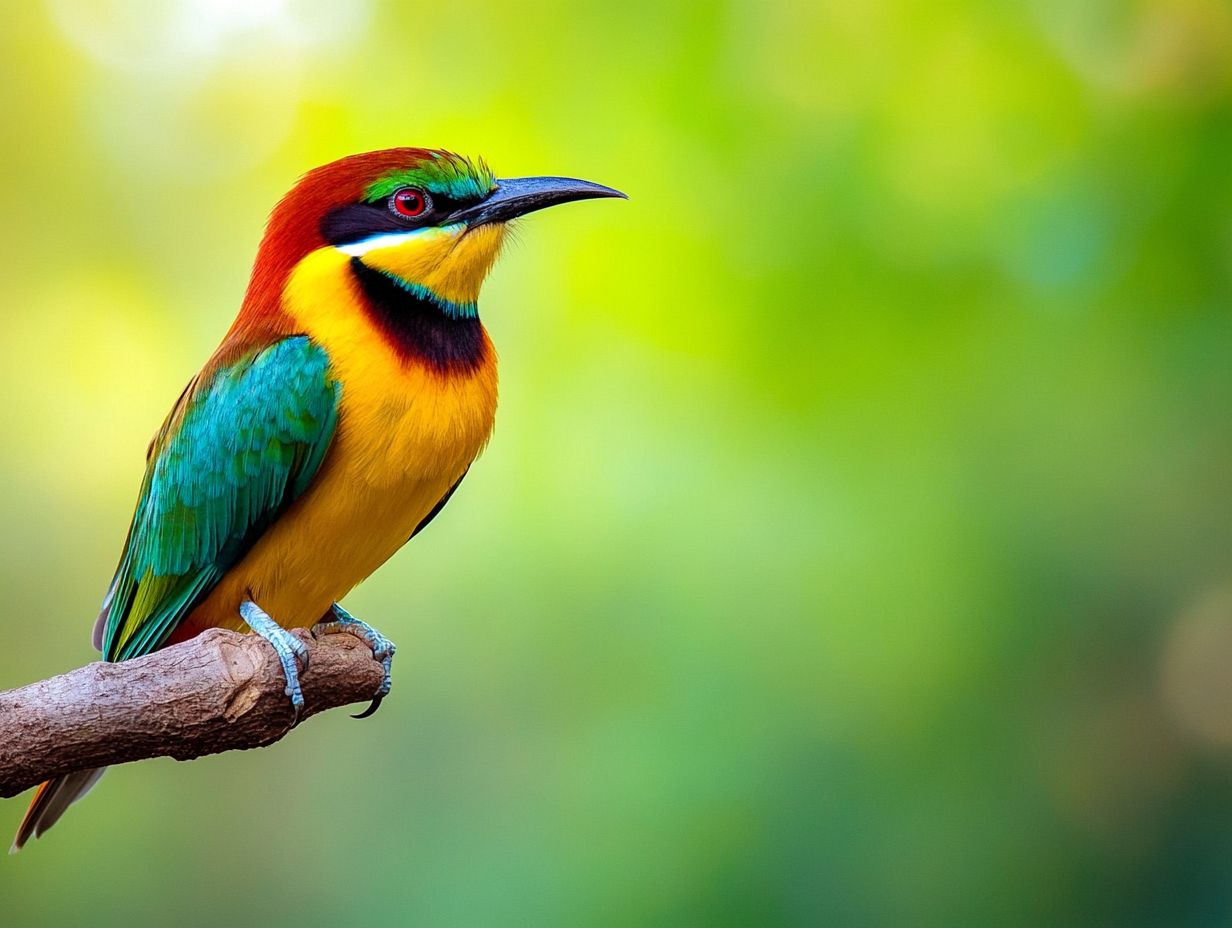
Depth of field refers to the range of distance in a photograph that appears in sharp focus. In bird photography, understanding depth of field is important for capturing a clear and detailed image of the bird while creating a pleasing background blur, especially when using a fast professional lens.
How does aperture affect depth of field in bird photography?
The aperture is the opening in the lens that controls how much light enters the camera. It plays a major role in determining depth of field. A wider aperture (lower f-stop number) results in a shallower depth of field, while a smaller aperture (higher f-stop number) yields a deeper depth of field, particularly with telephoto lenses.
What is the ideal depth of field for bird photography?
The ideal depth of field varies based on personal preference and the specific shot. Generally, a shallow depth of field is preferred to isolate the bird from the background, creating a more artistic image. For example, when photographing hummingbirds or the Giant Antpitta, a shallower depth of field enhances the focus on the subject.
How can I achieve a shallow depth of field in my bird photography?
To achieve a shallow depth of field, use a wide aperture (lower f-stop number) and zoom in on the bird with a lens like the Nikon Z 180-600mm or Tamron 150-500mm. Shooting with a longer lens also helps create a shallower depth of field. Keep in mind the focus distance between you and the bird as this can impact your depth of field.
What is the effect of distance on depth of field in bird photography?
The closer you are to the bird, the shallower the depth of field will be. This means the bird will be in sharp focus while the background will be more blurred. Conversely, if you are shooting from a greater distance, the depth of field will be deeper, and more of the background will be in focus.
Are there any other factors that can affect depth of field in bird photography?
Yes! In addition to aperture and distance, the focal length of your lens (such as the Canon 600mm or Canon RF 100-500mm), the sensor size of your camera, and the distance between the subject and background can also impact depth of field. Consider the types of photographed birds, like the Crimson-rumped Toucanet or Masked Trogon, when determining your settings. Experimenting with different settings and techniques is key to discovering what works best for you!

